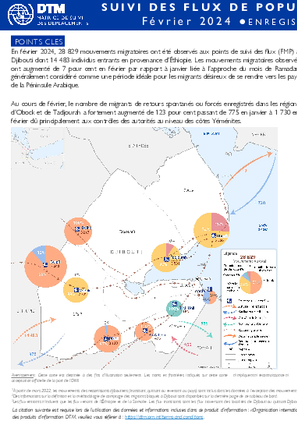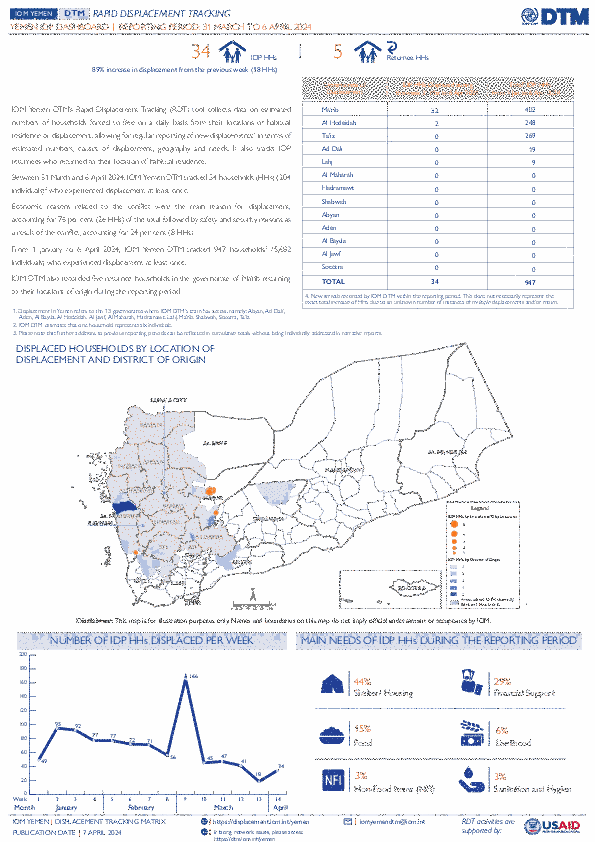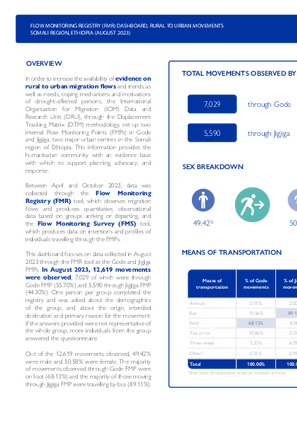-
Countries
-
Data and Analysis
-
Special Focus
-
Crisis Responses
Contact
DTMUKRAINE@IOM.INT
Location
Ukraine
Activity
- Mobility Tracking
Period Covered
Feb 01 2024 -Feb 29 2024
IOM's Data and Analytics (D&A) Unit developed the Mobility and Needs Assessment (MaNA), a monthly, multi-sectoral assessment designed to systematically monitor the estimated current presence of key population groups, including de facto Internally Displaced Persons (IDPs), returnees and non-displaced residents, at the hromada level. MaNA also offers a regular baseline for evaluating population needs at a granular level, with a specific focus on hard-to-reach areas. It utilizes sector specific indicators, serving as a compass to steer humanitarian programming and response efforts.
This report presents the primary findings from the sixth round of MaNA, conducted in February 2024 across 255 hromadas located in 23 oblasts and Kyiv City. Assessed hromadas were selected based on their relevance to humanitarian programming, pre-war population size, and known displacement trends.
This is a restricted dataset. To get access, kindly click on the 'Request Access' button.
Population Groups
IDPs
Residents
Returnee (Previously Internally Displaced)
Survey Methodology
Unit of Analysis Or Observation
Admin Area 2
Admin Area 3
Site or Location
Type of Survey or Assessment
Key Informant
Keywords
Geographical Scope Partial Coverage
Administrative boundaries with available data
The current dataset covers the following administrative boundaries
Contact
IOMKABULDTMALLUSERS@iom.int
Location
Afghanistan
Activity
- Mobility Tracking
- Site Assessment
Period Covered
Jan 25 2024 -Feb 29 2024
IOM Afghanistan launched the first round of the DTM Baseline Area Assessment B1 in January 2024 as part of its ongoing efforts to collect crucial data on population mobility dynamics, specifically displacement and returns. In particular, the B1 activity seeks to map the presence of mobile population groups, such as Internally Displaced Persons (IDPs), returnees, and internal migrants, to enable further understanding of conditions, vulnerabilities, and humanitarian needs through targeted data collection and analysis.
The community-level dataset is available based on request only, to get access kindly click on the 'Request Access' button.
Population Groups
IDPs
Returnee (Previously Displaced Abroad)
Returnee (Previously Internally Displaced)
Survey Methodology
Unit of Analysis Or Observation
Admin Area 2
Site or Location
Type of Survey or Assessment
Key Informant
Keywords
Geographical Scope Partial Coverage
Administrative boundaries with available data
The current dataset covers the following administrative boundaries

Contact
DTM Djibouti, DTMDjibouti@iom.int
Language
English
Location
Djibouti
Period Covered
Feb 01 2024
Feb 29 2024
Activity
- Flow Monitoring
En février 2024, 28 829 mouvements migratoires ont été observés aux points de suivi des flux (FMP) à Djibouti dont 14 483 individus entrants en provenance d’Éthiopie. Les mouvements migratoires observés ont augmenté de 7 pour cent en février par rapport à janvier liée à l’approche du mois de Ramadan généralement considéré comme une période idéale pour les migrants désireux de se rendre vers les pays
de la Péninsule Arabique.
Au cours de février, le nombre de migrants de retours spontanés ou forcés enregistrés dans les régions d’Obock et de Tadjourah a fortement augmenté de 123 pour cent passant de 775 en janvier à 1 730 en février dû principalement aux contrôles des autorités au niveau des côtes Yéménites.

Contact
DTM Djibouti, DTMDjibouti@iom.int
Language
English
Location
Djibouti
Period Covered
Feb 01 2024
Feb 29 2024
Activity
- Flow Monitoring
In February 2024, 28,829 migratory movements were observed at Djibouti's Flow Monitoring Points (FMPs), including 14,483 incoming individuals from Ethiopia. The observed migratory movements increased by 7 per cent in February compared with January, linked to the approach of the month of Ramadan, generally considered to be an ideal time for migrants wishing to travel to the countries in the Arabian
Peninsula.
During February, the number of spontaneous or forced return migrants recorded in the Obock and Tadjourah regions rose sharply by 123 per cent, from 775 in January to 1,730 in February, mainly due to checks by the authorities on the Yemeni coast.
Contact
DTM Sudan, DTMSudan@iom.int
Location
Sudan
Activity
- Mobility Tracking
- Baseline Assessment
Period Covered
Feb 22 2024 -Mar 21 2024
- DTM Sudan estimates that 6,552,118 individuals (1,308,617 households) have been recently internally displaced.
- IOM DTM also reports that an estimated 2,019,027 mixed cross-border movements have been made into neighbouring countries.
- Since 15 April 2023, 46 per cent of the IDP caseload sought refuge in the Darfur and Kordofan regions, whereas 53 per cent were observed across the Northern, Eastern, and Central states.
- The majority of the IDP caseload (66%) were seeking shelter with the host community.
- While food remains the highest priority need, health and non-food items are also growing concerns.
A more detailed version of this dataset is available, to get access kindly click on the 'Request Access' button
Population Groups
IDPs
Survey Methodology
Unit of Analysis Or Observation
Admin Area 3
Site or Location
Type of Survey or Assessment
Key Informant
Keywords
Geographical Scope Partial Coverage
Administrative boundaries with available data
The current dataset covers the following administrative boundaries
Contact
DTMAFGHANISTAN@iom.int
Location
Afghanistan
Activity
- Flow Monitoring Survey
Period Covered
Jan 10 2024 -Mar 31 2024
IOM Afghanistan's DTM Flow Monitoring activity, initiated at the beginning of 2024, seeks to quantify and better understand the mobility dynamics at Afghanistan’s borders. On 10 January 2024, DTM began deploying field teams at four border crossing points with the Islamic Republic of Iran (IRN) and Pakistan (PAK), expanding to another border crossing point Ghulam Khan as of 11 February for a headcount of all individuals entering or leaving Afghanistan (including returnees), also called Flow Monitoring Counting (FMC), to gauge flow volume.
Population Groups
Migrants Present
Survey Methodology
Unit of Analysis Or Observation
Other
Type of Survey or Assessment
Keywords
Geographical Scope Partial Coverage
Administrative boundaries with available data
The current dataset covers the following administrative boundaries
Contact
DTM Sudan, DTMSudan@iom.int
Location
Sudan
Activity
- Mobility Tracking
- Baseline Assessment
Period Covered
Mar 21 2024 -Mar 28 2024
- DTM Sudan estimates that 6,622,565 individuals (1,320,273 households) were recently internally displaced.
- The IDP caseload was observed in 7,076 locations across all of Sudan’s 18 states.
- The highest proportions of IDPs were observed across South Darfur (11%), River Nile (11%), and East Darfur (10%).
- Field teams reported that the IDPs observed were originally displaced from twelve states. The majority (3,570,032 IDPs, 54%) were reportedly displaced from Khartoum state; followed by South Darfur (15%), Aj Jazirah (9%), North Darfur (9%), Central Darfur (4%), West Darfur (4%), South Kordofan (2%), East Darfur (1%), West Kordofan (1%), North Kordofan (1%), Sennar (1%) and White Nile (<1%).
- IOM-DTM also reported that an estimated 2,031,858 mixed cross-border movements were made into neighbouring countries.
- This product provides brief insights into those displaced in Sudan post-15 April 2023. For more granular information on the IDP caseload and the displacement context, please see IOM-DTM's Monthly Displacement Overview 07.
A more detailed version of this dataset is available, to get access kindly click on the 'Request Access' button
Population Groups
IDPs
Survey Methodology
Unit of Analysis Or Observation
Site or Location
Type of Survey or Assessment
Key Informant
Keywords
Geographical Scope Partial Coverage
Administrative boundaries with available data
The current dataset covers the following administrative boundaries
Contact
DTM Yemen, iomyemendtm@iom.int
Location
Yemen
Activity
- Mobility Tracking
- Event Tracking
Period Covered
Mar 31 2024 -Apr 06 2024
From 1 January to 6 April 2024, IOM Yemen DTM tracked 947 households (HH) (5,682 Individuals) who experienced displacement at least once.
Between 31 March and 6 April 2024, IOM Yemen DTM tracked 34 households (204 individuals) displaced at least once. The majority of people moved into/within the following governorates and districts:
- Ma’rib (32 HHs) – Ma’rib City (17 HHs), Ma’rib (10 HHs), Harib (5 HHs) districts. Most displacements in the governorate originated from Al Hodeidah and Ma’rib.
- Al Hodeidah (2 HHs) – Hays (2 HHs) district. All displacements in the governorate originated from Ta’iz.
The majority of people moved from the following governorates and districts:
- Al Hodeidah (9 HHs) – Bajil (5 HHs), Az Zaydiah (2 HHs), At Tuhayta (2 HHs) districts.
- Ta’iz (5 HHs) – Maqbanah (2 HHs), Jabal Habashi (1 HH), Sharab As Salam (1 HH) districts.
- Ma’rib (5 HHs) – Al Abdiyah (3 HHs), Harib (1 HH), Raghwan (1 HH) districts.
Population Groups
Survey Methodology
Unit of Analysis Or Observation
Type of Survey or Assessment
Keywords
Geographical Scope
Administrative boundaries with available data
The current dataset covers the following administrative boundaries

Contact
DTM Yemen, iomyemendtm@iom.int
Language
English
Location
Yemen
Period Covered
Mar 31 2024
Apr 06 2024
Activity
- Mobility Tracking
- Event Tracking
IOM Yemen DTM’s Rapid Displacement Tracking (RDT) tool collects data on estimated numbers of households forced to flee on a daily basis from their locations of origin or displacement, allowing for regular reporting of new displacements in terms of estimated numbers, geography, and needs. It also tracks returnees who returned to their location of origin.
From 1 January to 6 April 2024, IOM Yemen DTM tracked 947 households (HH) (5,682 Individuals) who experienced displacement at least once.
Between 31 March and 6 April 2024, IOM Yemen DTM tracked 34 households (204 individuals) displaced at least once. The majority of people moved into/within the following governorates and districts:
- Ma’rib (32 HHs) – Ma’rib City (17 HHs), Ma’rib (10 HHs), Harib (5 HHs) districts. Most displacements in the governorate originated from Al Hodeidah and Ma’rib.
- Al Hodeidah (2 HHs) – Hays (2 HHs) district. All displacements in the governorate originated from Ta’iz.
The majority of people moved from the following governorates and districts:
- Al Hodeidah (9 HHs) – Bajil (5 HHs), Az Zaydiah (2 HHs), At Tuhayta (2 HHs) districts.
- Ta’iz (5 HHs) – Maqbanah (2 HHs), Jabal Habashi (1 HH), Sharab As Salam (1 HH) districts.
- Ma’rib (5 HHs) – Al Abdiyah (3 HHs), Harib (1 HH), Raghwan (1 HH) districts.
IOM identified 9 households displaced in the previous reporting period, which covered 24 - 30 March 2024, in the governorates of Ma'rib (6 HHs), Al Hodeidah (2 HHs), and Ta’iz (1 HH). These figures have been added to the cumulative displacement total recorded since the beginning of the year.

Contact
DTM Ethiopia, DTMEthiopia@iom.int
Language
English
Location
Ethiopia
Period Covered
Aug 01 2023
Aug 31 2023
Activity
- Flow Monitoring
In order to increase the availability of evidence on rural to urban migration flows and trends, as well as needs, coping mechanisms and motivations of drought-affected persons, the International Organization for Migration (IOM) Data and Research Unit (DRU), through the Displacement Tracking Matrix (DTM) methodology, set up and piloted two internal Flow Monitoring Points (FMPs) in Gode and Jigjiga, two major urban centres in the Somali region of Ethiopia. The pilot ran from June 2023 through August 2023.
This dashboard focuses on data collected in August 2023 through the FMR tool in Gode and Jigjiga FMPs. In August 2023, 12,619 movements were observed, 7,029 of which were through Gode FMP (55.70%) and 5,590 through Jigjiga FMP (44.30%).